Go through the enVision Math Common Core Kindergarten Answer Key Topic 11 Count Numbers to 100 and finish your homework or assignments.
enVision Math Common Core Grade K Answers Key Topic 11 Count Numbers to 100
Essential Question
How can numbers to 100 be counted using a hundred chart?

enVision’STEM Project: Ant Colonies
Directions Read the character speech bubbles to students. Find Out! Have students find out how ants live and work together in colonies. Say: Talk to friends and relatives about ant colonies. Ask about the different jobs ants in a colony might have that help them survive. Journal: Make a Poster Have students make a poster. Have them draw an ant colony with 5 groups of ants. There should be 10 ants in each group. Then have them count by tens to find how many ants there are in all. Hove students use a hundred chart to practice counting by tens to 50.
Review what You Know
Question 1.

Answer:
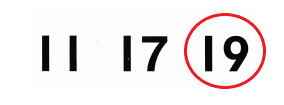
Explanation:
I drew a circle around the number ninteen.
Question 2.
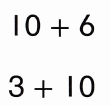
Answer:

Explanation:
I circled 10+6 as 10+6=16
I drew a circle around the addition expression that makes 16.
Question 3.

Answer:

Explanation:
I circled 10+8 as 10+8=18
I drew a circle around the addition expression that makes 18.
Question 4.
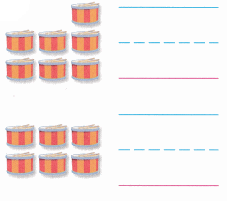
Answer:

Explanation:
There are 7 objects in the first set and 6 objects in the second set.So, the wrote the numbers 7, 6 in the blanks and i circled 7 as it is greater than 6.
Question 5.
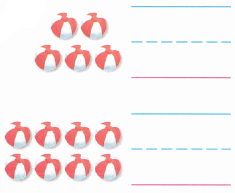
Answer:
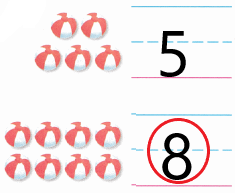
Explanation:
There are 5 objects in the first set and 8 objects in the second set.So, the wrote the numbers 5, 8 in the blanks and i circled as it is greater than 5.
Question 6.

Answer:

Explanation:
There are 4 objects in the first set and 10 objects in the second set.So, the wrote the numbers 4, 10 in the blanks and i circled 10 as it is greater than 4.
Directions Have students: 1 draw a circle around the number nineteen; 2 draw a circle around the addition expression that makes 16; 3 draw a circle around the addition expression that makes 18; 4-6 count each set of objects, write the numbers to tell how many, and then draw a circle around the number that is greater than the other number.
Pick a project
A

B

C

Directions Say: You will choose one of these projects. Look at picture A. Think about this question. What if you had more than two legs? If you choose Project A, you will make o model of a centipede. Look at picture B. Think about this question: Is there any math in dancing? If you choose Project B, you wilt create a numbers dance. Look at picture C. Think about this question: Where can you find a moonstone? If you choose Project C, you wilt collect and count treasures.
3-ACT MATH PREVIEW
Math Modeling
Stack Up

Directions Read the robot’s speech bubble to students. Generate Interest Ask students about their experience stacking blocks. Say: What’s the tallest block tower you have built? How many blocks was it? Give students a chance to practice building block towers and observe how many blocks tall they are.
Lesson 11.1 Count Using Patterns to 30

Directions Say: Count forward from 1 to 30. Count aloud and point to each number as you say it. What patterns do you see or hear when you count to 30 using the numbers on the chart? Color the boxes that show a pattern you find
Visual Learning Bridge

Guided Practice

Answer:

Explanation:
I counted forward from 1 to 10, circled the number in the top row and the part of the number in the bottom row that sound alike: twenty-ONE‘ twenty-TWO, twenty-THREE, twenty-FOUR twenty-FIVE, twenty-SIX.
Directions Have students: 1 count forward from 1 to 10. Count aloud and point to each number as it is said. Have them listen to the following numbers in the bottom row, and then draw a circle around the number in the top row and the part of the number in the bottom row that sound alike: twenty-ONE‘ twenty-TWO, twenty-THREE, twenty-FOUR twenty-FIVE, twenty-SIX. 2 listen to the pattern, and then use crayons to color the numbers that they hear: 16, 17, 18, 19.

Answer:

Explanation:
I colored the numbers that i heard they are 16, 17, 18, 19.
I can see and hear the pattern of counting by ones.

Answer:

Explanation:
3) I colored the numbers that i heard they are 1, 2, 3, 4, 5.
4) I colored the numbers that i heard they are 25, 26, 27, 28.
I can see and hear the pattern of counting by ones.

Answer:

Explanation:
5) I colored the numbers that i heard they are 4, 14, 24.
6) I colored the numbers that i heard they are 16, 17, 18, 19.
I can see and hear the pattern of counting by ones and by tens.
Directions Have students listen to the count, color the numbers they hear, and then tell what pattern they see or hear: 3 1, 2, 3, 4, 5; 4 25, 26, 27, 28; 5 4, 14, 24; 6 16, 17, 18, 19.
Independent Practice

Answer:

Explanation:
7) I colored the numbers that i heard they are 7, 17, 27.
8) I colored the numbers that i heard they are 21, 22, 23, 24, 25.
I can see and hear the pattern of counting by ones and tens.

Answer:

Explanation:
I colored the numbers that i heard they are 13, 14, 15, 16, 17, 18 and circled the next number in the pattern that is 19.
I can see and hear the pattern of counting by ones.
Directions Have students listen to the count, color the numbers they hear, and then tell what pattern they see or hear: 7 7, 17, 27; 8 21,22, 23, 24, 25. 9 Higher Order Thinking Have students listen to the count, color the numbers they hear, and then tell what pattern they hear: 13, 14, 15, 16, 17, 18. Then have them draw a circle around the next number in the pattern.
Lesson 11.2 Count by Ones and by Tens to 50
Solve & Share
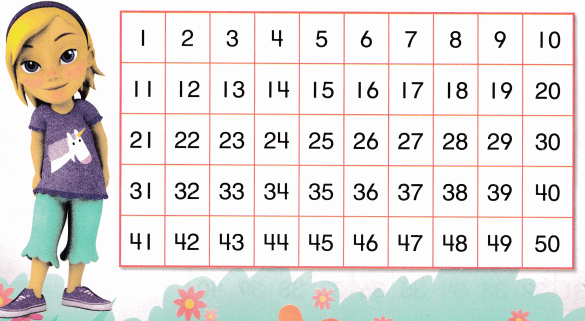
Directions Say : Work with a partner. Count forward from 1 to 50. One partner points to each number in the first row while the other partner counts aloud each number. Change jobs for every row. Watch students go through all 5 rows. Say: Now, one partner will cover some numbers on the board using counters. The other partner will name the hidden numbers. Play 3 times, and then color the numbers that are the hardest to remember.
Visual Learning Bridge

Guided Practice

Answer:

Explanation:
I counted the numbers in the middle row beginning with 31 and ending with 39, and drew a circle around the part of the number that sounds the same that is 3tens(thirty)
I read the numbers in the first column and drew a circle around the number 1(ones) that i hear in each number.
Directions Have students: 1 count aloud the numbers in the top row and point to each number as it is said. Then have them count aloud the numbers in the middle row beginning with 31 and ending with 39, and draw a circle around the part of the number that sounds the same; 2 read the numbers in the first column. Draw a circle around the number that you hear in each number.

Answer:

Explanation:
3)I found green number 20 and started counting up till 30 and colored the numbers green that has twenty as part of the number.
4)I found the red number 39 and started counting up till 49 and colored the numbers red.
5)I found the yellow number 33 amd started counting up till the next red number, colored the numbers yellow.
6)I found the blue number 20 and drew a circle around the parts of the numbers in the column that are the same.
7)I used counters to cover 3 numbers on the chart they are 14, 15, 16.
Directions Have students: 3 find the green number on the chart, and then begin counting forward by ones up to 30. Say: Color green all the numbers that have “twenty” as part of the number, 4 Find the red number and begin counting forward by ones and stop when they get to 49. Say: Color red all the numbers you counted; 5 find the yellow number. Then have them count forward by ones until they get to the red number. Say: What numbers did you count? Color them yellow, 6 find the blue number. Then draw a circle around the parts of the numbers in the column that are the same; 7 use counters to cover 3 numbers on the chart. Say: Show your chart to a friend, and ask them to tell you which numbers are hiding.
Independent Practice

Answer:
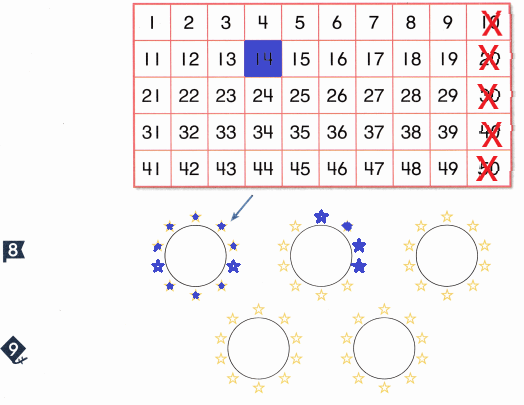
Explanation:
8)I started counting stars around the first circle at the arrow, crossed the number 10, counted all stars around all the circles and marked the last number of stars after each circle, they are 20, 30, 40, 50.
9)I colored the number 14 and colored 14 numbe rof stars in the below.
Directions 8 Have students begin counting stars around the first circle at the arrow, and continue clockwise around the circle until they have counted all the stars. Say: When you finish counting one circle, cross off the last number you said in your count on the chart. Have students continue counting the stars around the circles, crossing off the last number they said in each circle, until they reach the end of the stars. 9 Higher Order Thinking Say: Color one number in the chart. Now count that same number of stars below. Color each star to show how many you counted.
Lesson 11.3 Count by Tens to 100
Solve & Share

Directions Say: Color all the boxes of the numbers that have a zero as you count them aloud. Tell how you know which numbers to count. Count forward by tens beginning at 30 and going to 100. Point to the numbers as you count them aloud to a partner. Now begin at 60. Count forward by tens to 100. Mark each number with an X as you say it to your partner.
Visual Learning Bridge

Guided Practice
Question 1.

Answer:

Explanation:
I circled 30.
I drew a circle around the decade number that comes before 40 but after 20 that is 30.
Question 2.

Answer:
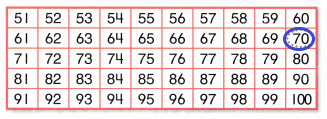
Explanation:
I circled 70.
I circled the decade number that is missing from this pattern: 60, 80, 90, 100 that is 70.
Directions Have students: 1 draw a circle around the decade number that comes before 40 but after 20; 2 circle the decade number that is missing from this pattern: 60, 80, 90, 100.
Question 3.

Answer:

Explanation:
I circled 40, 60, 80, 90.
I circled the missing numbers in the following pattern: ten, twenty, thirty, ___, fifty, __ seventy, ____, ___, one hundred they are 40, 60, 80, 90.
Question 4.

Answer:
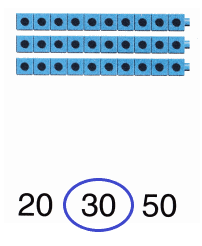
Explanation:
I counted by tens, there are 30 cubes in the above image.
I circled 30.
Question 5.

Answer:

Explanation:
I counted by tens, there are 70 cubes in the above image.
I circled 70.
Question 6.

Answer:
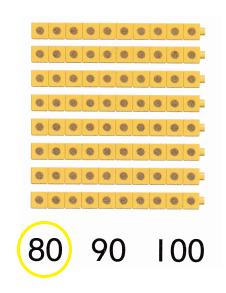
Explanation:
I counted by tens, there are 80 cubes in the above image.
I circled 80.
Directions Have students: 3 draw a circle around the missing numbers in the following pattern: ten, twenty, thirty, ___, fifty, __ seventy, ____, ___, one hundred; 4-6 count the cubes by tens, and then draw a circle around the number that tells how many.
Independent Practice
Question 7.

Answer:

Explanation:
I counted by tens, there are 60 cubes in the above image.
I circled 60.
Question 8.

Answer:
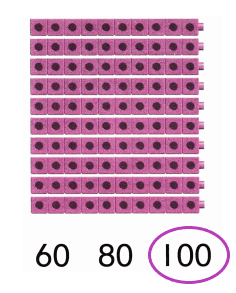
Explanation:
I counted by tens, there are 100 cubes in the above image.
I circled 100.
Question 9.

Answer:

Explanation:
If i start counting forward by tens from 40, the next tens are 50, 60, 70, 80, 90 and 100.
Therefore i circled the numbers by tens from 40 to 100.
Question 10.

Answer:

Explanation:
There are 10 decade numbers in the number chart.They are 10, 20, 30, 40, 50, 60, 70, 80, 90 and 100.
Directions 7-8 Have students count the cubes, and then draw a circle around the number that tells how many. 9 Say: If you start with 40, how would you count to 100 by tens? Circle the numbers you count. 10 Higher Order Thinking Have students look at the hundred chart and read the decade numbers. Say: How many decade numbers are there in the chart? Write the number.
Lesson 11.14 Count by Ones to 100
Solve & Share

Directions Say: Count forward from the yellow number. Stop at the red number. Tell how many numbers you counted aloud. Color the boxes of the numbers you counted aloud to show your work. Have students repeat the same steps for the blue to green sequence of squares, and for the orange to purple sequence of squares.
Visual Learning Bridge

Guided practice
Question 1.

Answer:

Explanation:
I colored the boxes of the numbers, starting at the yellow box 42 and ending at the red box 60.
Question 2.

Answer:

Explanation:
I colored the boxes of the numbers, starting at the yellow box 7 and ending at the red box 22.
Directions 1 and 2 Have students color the boxes of the numbers as they count aloud, starting at the yellow box and ending at the red box.
Question 3.

Answer:

Explanation:
I colored the boxes of the numbers, starting at the yellow box 34 and ending at the red box 55.
Question 4.

Answer:

Explanation:
I colored the boxes of the numbers, starting at the yellow box 79 and ending at the red box 100.
Question 5.

Answer:

Explanation:
I colored the boxes of the numbers, starting at the yellow box 1 and ending at the red box 28.
Question 6.

Answer:

Explanation:
I colored the boxes of the numbers, starting at the yellow box 56 and ending at the red box 76.
Directions 3-6 Have students color the boxes of the numbers as they count aloud, starting at the yellow box and ending at the red box. 
Question 7.

Answer:

Explanation:
I colored the boxes of the numbers, starting at the yellow box 12 and ending at the red box 33.
Question 8.

Answer:

Explanation:
I colored the boxes of the numbers, starting at the yellow box 63 and ending at the red box 85.
Question 9.

Answer:

Explanation:
I colored the boxes of the numbers, starting at the yellow box 47 and ending at the red box 64.
Question 10.

Answer:

Explanation:
I colored the box of the missing number: 79, 80, 81,83, 84, 85, 86, 87, 88 that is 82.
I circled the numbers in the chart that are I more and I less than the missing number they are 81 and 83.
Directions 7-9 Have students color the boxes of the numbers as they count aloud, starting at the yellow box and ending at the red box. 10 Higher Order Thinking Have students listen to the count, and then color the box of the missing number: 79, 80, 81,83, 8*4, 85, 86, 87, 88. Say: Circle the numbers in the chart that are I more and I less than the missing number.
Lesson 11.5 Look For and Use Structure
Problem Sharing
Solve & Share

Directions Say: Carlos looks at the chart. He knows 21 comes just after 20. Draw a circle around the numbers that come just after each decade number. How do you know you are correct? What patterns do you see?
Visual Learning Bridge

Guided Practice
Question 1.

Answer:

Explanation:
I circled the numbers that i counted from 7 to 9.They are 7, 8 , 9.
Question 2.

Answer:

Explanation:
I circled the numbers that i counted by tens from 10 to 30, they are 10, 20, 30.
Directions Have students 1 count forward by ones, beginning at 7 and going to 9. Have them circle the counted numbers. Then 2 count forward by tens, beginning at 10 and going to 30. Have them circle the counted numbers.
Independent Practice
Question 3.

Answer:

Explanation:
The numbers that come after 65 if we count by 1s are 66, 67, 68
I circled the set of numbers 66, 67, 68 as they are the missing numers in the above number chart.
Question 4.

Answer:

Explanation:
The numbers that come before 44 if we count by 1s are 41, 42, 43.
I circled the set of numbers 41, 42, 43 as they are the missing numers in the above number chart.
Question 5.
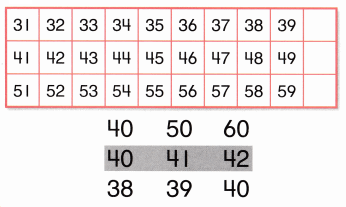
Answer:
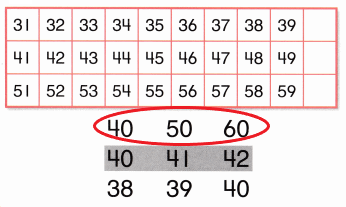
Explanation:
The numbers that come after 39 if we count by 10s are 40, 50, 60.
I circled the set of numbers 40, 50, 60 as they are the missing numers in the above number chart.
Question 6.

Answer:

Explanation:
The numbers that come after 29 if we count by 1s are 30, 31, 32
I circled the set of numbers 30, 31, 32 as they are the missing numers in the above number chart.
Directions 3-6 Have students count forward, and then draw a circle around the row that shows the missing set of numbers.
Problem Solving
Performance Task

Answer:

Explanation:
7)I counted up 18 squares, Used yellow crayon to make a path to show how i counted, and then i drew a circle around the number 25 where i ended.
8)If i counted by ones the would say 7, 8, 9, 10, 11, 12, 13, 14, 15, 16, 17, 18, 19, 20, 21, 22, 23, 24, 25.
9)If i start counting at 10 and count up 17 squares, i would land on the number 27.No, there is no different way to count other than counting by 1s or 10s.
Directions Read the problem aloud. Then have students use multiple problem-solving methods to solve the problem. Say: Start at 7 and count up 18 squares in any way you choose. Use your yellow crayon to make a path to show how you counted, and then draw a circle around the number where you ended. 7 Be Precise How many tens are in 18? 8 Use Structure What numbers would you say if you only counted by ones? 9 Generalize Start at 10 and count up 17 squares. On what number did you land? Would there be a different way to count that would solve the problem?
Topic 11 Fluency Practice Activity
Question 1.

Answer:

Explanation:
2+2=4=3+1=B
3-1=2=4-2=I
4+1=5=2+3=G
By solving the addition and subraction statements i found the word BIG with the clues given.
Question 2.

Answer:

Explanation:
5-5=0=3-3=C
4-3=1=5-4=A
0+3=3=1+2=T
By solving the addition and subraction statements i found the word CAT with the clues given.
Directions 1 and 2 Have students find a partner. Have them point to a clue in the top row, and then solve the addition or subtraction problem in the clue. Then have them look at the clues in the bottom row to find a match, and then write the clue letter above the match. Have students find a match for every clue.
Topic 11 Vocabulary Review

Answer:
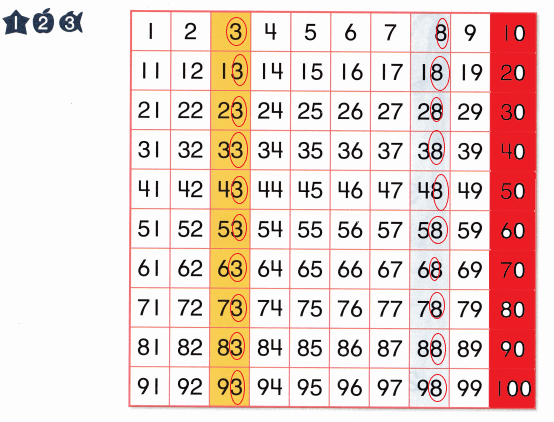
Explanation:
1)I drew a circle around the part of the number in the orange column that is 3 ones
2)I drew a circle around the part of the number in the blue column that shows the pattern of 8 ones
3)I colored the decade numbers red.
Directions Understand Vocabulary Have students: 1 draw a circle around the part of the number in the orange column that is 3 ones. 2 draw a circle around the part of the number in the blue column that shows the pattern of 8 ones; 3 color the decade numbers red.
Topic 11 Reteaching
Set A

Question 1.

Answer:

Explanation:
I drew a circle around the numbers in the top row and the part of the number in the bottom row that sound the same.
Set B
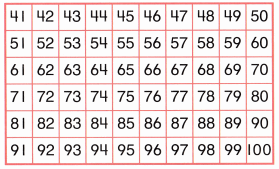
Question 2.

Answer:

Explanation:
I counted by 10s, there are 80 cubes in the above image.
So, I circled 80.
Directions Have students: 1 count aloud the numbers in the top row. Then have them count aloud the numbers in the bottom row and draw a circle around the number in the top row and the part of the number in the bottom row that sound the same; 2 count by tens, and then draw a circle around the number that tells how many.
Set C

Question 3.

Answer:

Explanation:
I colored the boxes of the numbers, starting at the yellow box 69 and ending at the red box 80.
Set D

Question 4.

Answer:

Explanation:
I counted forward by 10s from 66, the next decades are 76, 86, 96.
So, i circled the set of missing numbers 76, 86, 96.
Directions Have students: 3 color the boxes of the numbers as they count aloud by ones, starting at the yellow box and ending at the red box; 4 count forward, and then draw a circle around the row that shows the missing set of numbers.
Topic 11 Assessment Practice
Question 1.

Answer:

Explanation:
I counted by 10s, there are 70 cubes in the above image.
So, I circled option(B) 70.
Question 2.

Answer:
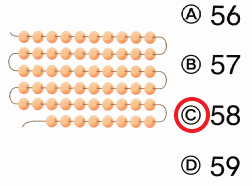
Explanation:
I counted by 1s, there are 58 beads in the above image.
So, I circled option(C) 58.
Question 3.

Answer:

Explanation:
I counted by 10s, After 70, the numbers are 80, 90, 100.
So, I circled option(A) 80, 90, 100.
Directions Have students mark the best answer. 1 Which number tells how many cubes? 2 Count the beads by ones. Which number tells how many? 3 Which set of numbers shows the set of missing numbers in the number chart?
Question 4.

Answer:

Explanation:
I number that is just before the yellow numbers is 22.So, i circled Option(A).
Question 5.

Answer:

Explanation:
I started counting at 61 and drew a circle around the part of the number that sounds the same to show the pattern that is sixty, and then draw a circle around the column that has decade numbers 60, 70, 80, 90, 100.
Question 6.

Answer:

Explanation:
I colored the boxes of the numbers, starting at the yellow box 77 and ending at the red box 94.
Question 7.

Answer:

Explanation:
I counted by ones to write the missing numbers in the top row they are 16, 20, and then drew a circle around each of the missing numbers in the remaining rows they are 22, 30, 33, 39, 40, 41, 47, 48, 55, 56.
Directions Have students: 4 look at the numbers that are shaded yellow and choose the number that is counted just before the first yellow number. 5 look at the row beginning with 61. Count each number aloud. Have them draw a circle around the part of the number that sounds the same to show the pattern, and then draw a circle around the column that has decade numbers; 6 color the boxes of the numbers as they count by ones, starting at the yellow box and ending at the red box, and then explain any patterns they might see or hear; 7 count by ones to write the missing numbers in the top row, and then draw a circle around each of the missing numbers in the remaining rows.
Topic 11 Performance Task
Question 1.

Answer:

Explanation:
If we count by 1s the number that comes after 18 is 19.SO, i circled 19.
Therefore, the missing number that tells how many grapes Keisha has is 19.
Question 2.

Answer:

Explanation:
I counted the almonds above by 10s, there are 50 almonds.
So, i circled 50.
Therefore, the number that tells how many almonds that Liam and his friends share for their snack is 50.
Directions School Snacks Say: It’s snack time for the Kindergarten class! 1 Say: Keisha puts a grape on the hundred chart to show how many grapes she has in her snack bag. Have students look at the numbers that come just before and just after the grape, and then at the numbers that are just above and just below it. Have them draw a circle around the missing number that tells how many grapes Keisha has. 2 Have students count the almonds that Liam and his friends share for their snack. Have them draw a circle around the number that tells how many. If needed, students can use the hundred chart to help.
Question 3.

Answer:

Explanation:
I counted by 1s, there are 16 crackers.So, I coloreed the number 16.
If each friend has I cracker then the crackers left over are 16-10=6.So, i colored 6.

Answer:

Explanation:
I started at 64 on the number chart and made a path to show how to count up 18 i colored the number boxes from 64 to 81 then i drew a circle around the number where i stopped which is 82.
Directions 3 Say: Chen brings crackers for snack time for his table of 10 friends. Look at the crackers he brings. Have students count the crackers and color that number on the number chart. Say: How many crackers are leftover if each friend has I cracker? Color that number on the chart. How do you know you are right? 4 Say: Zoe counts the cherries that she gives to her friends. She puts cherries on the number chart for the last three numbers that she counts. Have students find the cherries in the chart. Then have them look at the numbers to the right of the chart, and then draw a circle around the set of missing numbers to show how Zoe counted the cherries. 5 Say: Ty has 64 raisins in one bag. He has 18 raisins in another bag. Help Ty count his raisins. Have students start at 64 on the number chart and make a path to show how to count up 18 in any way they choose. Then have them draw a circle around the number where they stopped, and then explain how they counted up.